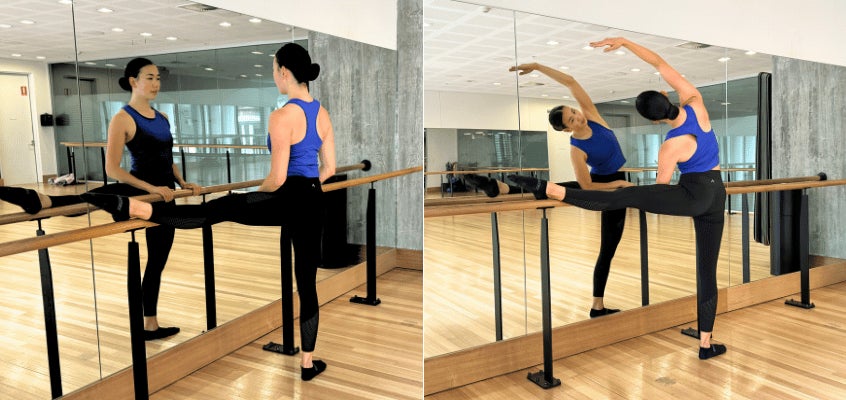Flex appeal: top stretches for better mobility
by Ploy Sirayanyong on Sunday 10 March 2024
5 min read
You’re not alone if you overlook stretching when it comes to your fitness routine. This doesn’t mean it isn’t important though. From greater range of motion in your joints, increased circulation, to promoting muscle recovery and reducing stress - stretching has many physical, mental and performance related benefits.
Types of stretches
Let's take a quick deep dive into the different types of stretches and see which ones you think would fit into your workout or wellness routine.
Dynamic
- Dynamic stretches are active movements that allow your muscles and joints to perform a full range of motion. Usually, dynamic movements mimic patterns you’re about to perform to warm up the body. For example, think of a professional swimmer before they jump on the block to start their race. You will often see them perform a dynamic mimic of the stroke (such as butterfly) outside of the water before jumping in.
Proprioceptive Neuromuscular Facilitation
- It's a big, fancy word. But I promise it isn't as confronting as it sounds. Proprioceptive Neuromuscular Facilitation (PNF) offers three types of stretches - contract-relax method, agonist-contract method, and contract-relax-agonist-contract method. To put it simply, you are stretching a muscle group to its limit. Your muscle will get to a point where it wants to 'stop', but after a short period of time, you are able to push a little bit more into the stretch as your exhale.
Static
- Static stretches are the most common and probably the main one you think of when you hear 'stretching'. A static stretch is just what it means! Holding a stretch in a static/still position for a period of time. Learn more about static vs dynamic stretches in this blog post.
Passive
- Love the idea of staying in one position for a set time? Passive stretches require you to relax your body while a friend, PT, prop, or accessory intensifies the stretch by putting external pressure on your body. You might have experienced passive stretches in one of our Yoga Calm classes.
Isometric
- The key word here is 'resistance'. Similar to static stretching, you use resistance through isometric contractions of the muscle groups. Think about your muscles 'tensing' or 'flexing'. A simple example would be using a wall to stretch your calf muscle while 'pushing the wall away' (even though you can't). Using this resistance isolates the calf muscle into a deep stretch.
Add stretching into your routine
The fantastic thing about stretching is you don’t need much space or equipment. Find a few minutes in your day: post-workout, after a meeting, while watching TV, or right before you say goodnight and hit the sheets. A few times a week will make a noticeable difference. I personally love stretching right after a workout to cool down. Plus, as I’m warm, holding stretches feels more comfortable.
Here are some of my must-try stretches that personally help me move better every day. I perform each for 30 seconds, with a small break, repeating 3-5 times.
Remember, resistance is good - but stretching shouldn’t be painful. If you're unsure, be sure to speak with a professional.
Hip flexor stretch
Tight hip flexors are common - especially if you spend your days sitting at desk. They’re shortened muscles, which can pull on your lower back and can become a source of pain. If this sounds like you - I highly suggest adding any type of hip flexor stretch into your routine.
Here's two examples for you to try.
- Stretch your hip flexors kneeling or lying down
- Kneel hip distance apart
- Step one foot forward, lean into your front leg (to feel the stretch in the hip of the back leg)
- Option: add a side bend with the opposite arm to add a deeper stretch for your back.
Need a bit more?
- Lie on an elevated area with your hips towards the edge
- Hug one knee into your chest (slightly engaging your abdominals)
- Press the opposite foot down towards the floor (even better if you can get someone to press your leg down).
Wall stretch
Let's utilise something that is always easily accessible. Wall stretches are perfect to enhance our stretch - especially through your shoulders, lats, chest and back. Try this:
- Place your hands on the wall or table
- Step your feet back
- Dive your chest to the floor.
Spine stretch
Spine mobility is so important. It supports our entire body, especially our posture, which is key in the support of our lower back and shoulder functioning. And pain free.
The cat-cow is a great place to start. You often see this performed in a Yoga class, however, you will be surprised how often this stretch is used through a range of sports.
- Start in the cow position with your hands and knees in tabletop.
- Inhale as your arch your back (cat pose) - gazing your body forward with a gentle curve in the spine.
- Exhale as you come back into an arch in your back. Round your spine upwards as your tuck your chin.
- Optional: you can utilise this as a flow - going back and forth from arching and rounding your spine. Be sure to keep notice of your breathing, matching your breath with the movements.
My personal favourite is thread the needle:
- On all fours, articulate one vertebra (spine bone) at a time as you arch your back up to the sky.
- Dive down the opposite way.
- To improve rotation, on all fours, take one arm out to the side, twist your upper back and arm to the ceiling (pushing the hand on the floor into the ground) and then dive your ear to the floor.
- Optional: to enhance your range, add a roller as a prop.
Hamstring stretch
You can try this one lying down, seated, standing, or even using the reformer bed by placing your feet in the straps. My preference is to use a wall, as there is something to push against.
- Stand with your back to the wall.
- Fold forward.
- Slowly walk one foot up the wall.
Keep in mind: the sciatic nerve can limit your hamstring flexibility. I suggest to try flossing before and see if you get more range - I certainly do! To do this:
- Lie down flat.
- Lift one leg to just before the point of your end range.
- Point and flex your foot 5 times whilst lifting and lowering your head.
- Repeat a few more times with your leg slightly elevated each time.
Inner thigh stretch
Tight inner thighs can limit your hip mobility. So let's loosen that up with this stretch. Similar to the hip flexor stretch, but we're turning on our side, putting pressure on our inner thighs.
- Start in a side lunge position with one leg bent and the other out behind your torso.
- Use one arm to stabilise your position, keep your spine neutral.
- Option: rise and reach with the other arm to elongate the stretch (same side arm as the bent leg).
Let's go deeper:
- Using a table, bench, or in my situation, a barre - place one foot up.
- Turn both legs out.
- Bend into the bottom leg and feel that muscle come alive!
- Option: add an arm bend to feel the stretch through your side muscles.
After a few examples, hopefully you're inspired to add some flex appeal into your workout and wellness routine. Start slow - there is no rush with flexibility and mobility. Listen to your body.
Don't forget, we offer a class just for stretching. Book into Reformer Recovery at Virgin Active. You'll be guided through a range of deep dynamic and static stretches, leaving you feeling lengthened, restored and alive.
About the author:
Ploy is fitness instructor at Virgin Active Australia, teaching all things Pilates, Barre, Reformer and HIIT. Ploy is a dedicated student, currently studying physiotherapy at university.
Growing up in the dance and fitness industry, Ploy evidentially found her passion for fitness and health. Her passion comes alive in her classes - as each class is designed to be challenging, innovative, full-body workouts that build strength, endurance and coordination (while having fun!). Virgin Active Members who attend her popular classes keep coming back for more as they continue to see results both physically and mentally. Be sure to catch one of her classes in one of our Sydney CBD clubs.
Related articles
Nourish
3 min read
Food mind games: how stress affects your appetite
Unwind
3 min read
Are you burnt out?
Nourish
3 min read
For wellness that lasts, ditch the trends and guilt
Enjoying our blog?
Sign up to our newsletter to get updates on training, healthy living, news and events.












